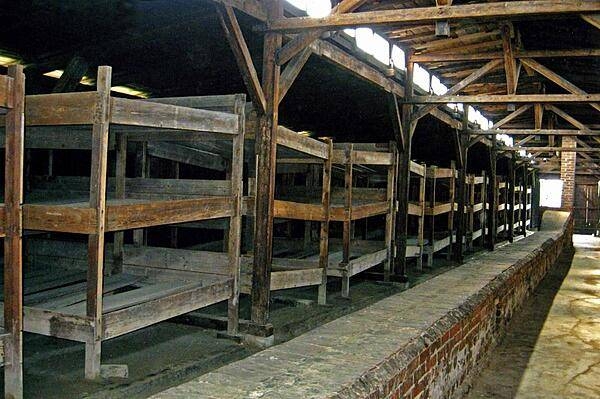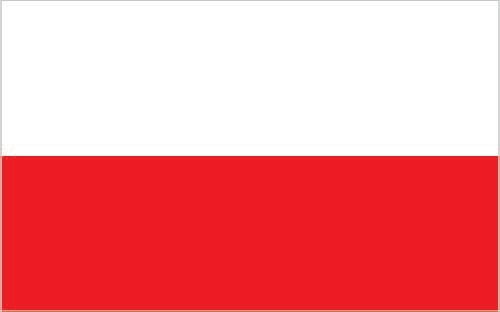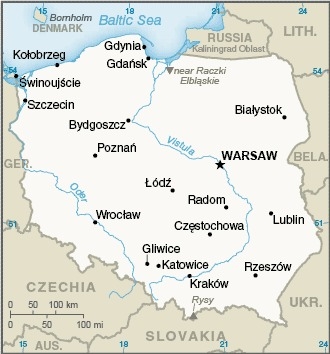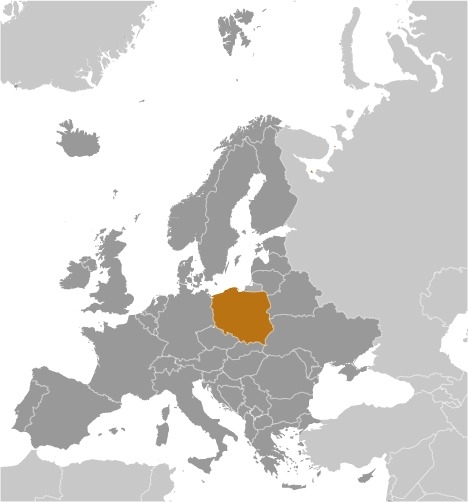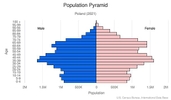Introduction
Background
Poland's history as a state began near the middle of the 10th century. By the mid-16th century, the Polish-Lithuanian Commonwealth ruled a vast tract of land in Central and Eastern Europe. During the 18th century, internal disorders weakened the nation, and in a series of agreements between 1772 and 1795, Russia, Prussia, and Austria partitioned Poland among themselves. Poland regained its independence in 1918 only to be overrun by Germany and the Soviet Union in World War II. It became a Soviet satellite state following the war. Labor turmoil in 1980 led to the formation of the independent trade union "Solidarity" that over time became a political force with over 10 million members. Free elections in 1989 and 1990 won Solidarity control of the parliament and the presidency, bringing the communist era to a close. A "shock therapy" program during the early 1990s enabled the country to transform its economy into one of the most robust in Central Europe. Poland joined NATO in 1999 and the EU in 2004.
Visit the Definitions and Notes page to view a description of each topic.
Geography
Location
Central Europe, east of Germany
Geographic coordinates
52 00 N, 20 00 E
Map references
Europe
Land boundaries
total: 2,865 km
border countries (7): Belarus 375 km, Czechia 699 km, Germany 467 km, Lithuania 100 km, Russia (Kaliningrad Oblast) 209 km, Slovakia 517 km, Ukraine 498 km
Coastline
440 km
Maritime claims
territorial sea: 12 nm
exclusive economic zone: defined by international treaties
Climate
temperate with cold, cloudy, moderately severe winters with frequent precipitation; mild summers with frequent showers and thundershowers
Terrain
mostly flat plain; mountains along southern border
Elevation
highest point: Rysy 2,499 m
lowest point: near Raczki Elblaskie -2 m
mean elevation: 173 m
Natural resources
coal, sulfur, copper, natural gas, silver, lead, salt, amber, arable land
Land use
agricultural land: 48.2% (2018 est.)
arable land: 36.2% (2018 est.)
permanent crops: 1.3% (2018 est.)
permanent pasture: 10.7% (2018 est.)
forest: 30.6% (2018 est.)
other: 21.2% (2018 est.)
Irrigated land
970 sq km (2012)
Major watersheds (area sq km)
Atlantic Ocean drainage: (Black Sea) Danube (795,656 sq km)
Major lakes (area sq km)
Salt water lake(s): Zalew Szczecinski/Stettiner Haff (shared with Germany) - 900 sq km
Major rivers (by length in km)
Vistula river source and mouth (shared with Belarus and Ukraine) - 1,213 km
note - longest river in Poland
Population distribution
population concentrated in the southern area around Krakow and the central area around Warsaw and Lodz, with an extension to the northern coastal city of Gdansk
Natural hazards
flooding
Geography - note
historically, an area of conflict because of flat terrain and the lack of natural barriers on the North European Plain
People and Society
Nationality
noun: Pole(s)
adjective: Polish
Ethnic groups
Polish 96.9%, Silesian 1.1%, German 0.2%, Ukrainian 0.1%, other and unspecified 1.7% (2011 est.)
note: represents ethnicity declared first
Languages
Polish (official) 98.2%, Silesian 1.4%, other 1.1%, unspecified 1.3%; note - data represent the language spoken at home; shares sum to more than 100% because some respondents gave more than one answer on the census; Poland ratified the European Charter for Regional or Minority Languages in 2009 recognizing Kashub as a regional language, Czech, Hebrew, Yiddish, Belarusian, Lithuanian, German, Armenian, Russian, Slovak, and Ukrainian as national minority languages, and Karaim, Lemko, Romani (Polska Roma and Bergitka Roma), and Tatar as ethnic minority languages (2011 est.)
major-language sample(s):
Księga Faktów Świata, niezbędne źródło podstawowych informacji. (Polish)
The World Factbook, the indispensable source for basic information.
Religions
Catholic 85% (includes Roman Catholic 84.8% and other Catholic 0.3%), Orthodox 1.3% (almost all are Polish Autocephalous Orthodox), Protestant 0.4% (mainly Augsburg Evangelical and Pentecostal), other 0.3% (includes Jehovah's Witness, Buddhist, Hare Krishna, Gaudiya Vaishnavism, Muslim, Jewish, Church of Jesus Christ), unspecified 12.9% (2020 est.)
Age structure
0-14 years: 14.83% (male 2,918,518/female 2,756,968)
15-24 years: 9.8% (male 1,928,637/female 1,823,894)
25-54 years: 43.33% (male 8,384,017/female 8,203,646)
55-64 years: 13.32% (male 2,424,638/female 2,675,351)
65 years and over: 18.72% (male 2,867,315/female 4,299,341) (2020 est.)
Dependency ratios
total dependency ratio: 51.4
youth dependency ratio: 23
elderly dependency ratio: 28.4
potential support ratio: 3.5 (2020 est.)
Median age
total: 41.9 years
male: 40.3 years
female: 43.6 years (2020 est.)
Population distribution
population concentrated in the southern area around Krakow and the central area around Warsaw and Lodz, with an extension to the northern coastal city of Gdansk
Urbanization
urban population: 60.1% of total population (2021)
rate of urbanization: -0.16% annual rate of change (2020-25 est.)
Major urban areas - population
1.790 million WARSAW (capital), 769,000 Krakow (2021)
Sex ratio
at birth: 1.06 male(s)/female
0-14 years: 1.06 male(s)/female
15-24 years: 1.06 male(s)/female
25-54 years: 1.02 male(s)/female
55-64 years: 0.91 male(s)/female
65 years and over: 0.67 male(s)/female
total population: 0.94 male(s)/female (2020 est.)
Mother's mean age at first birth
27.6 years (2019 est.)
Maternal mortality ratio
2 deaths/100,000 live births (2017 est.)
country comparison to the world: 184Infant mortality rate
total: 4.22 deaths/1,000 live births
male: 4.64 deaths/1,000 live births
female: 3.78 deaths/1,000 live births (2021 est.)
Life expectancy at birth
total population: 78.53 years
male: 74.76 years
female: 82.51 years (2021 est.)
Contraceptive prevalence rate
62.3% (2014)
Drinking water source
improved: urban: 100% of population
rural: 100% of population
total: 100% of population
unimproved: urban: 0% of population
rural: 0% of population
total: 0% of population (2017 est.)
Current Health Expenditure
6.3% (2018)
Physicians density
2.38 physicians/1,000 population (2017)
Hospital bed density
6.5 beds/1,000 population (2018)
Sanitation facility access
improved: urban: 99.7% of population
rural: 100% of population
total: 99.8% of population
unimproved: urban: 0.3% of population
rural: 0% of population
total: 0.2% of population (2017 est.)
Major infectious diseases
degree of risk: intermediate (2016)
vectorborne diseases: tickborne encephalitis (2016)
Literacy
definition: age 15 and over can read and write
total population: 99.8%
male: 99.9%
female: 99.7% (2015)
School life expectancy (primary to tertiary education)
total: 16 years
male: 15 years
female: 17 years (2019)
Unemployment, youth ages 15-24
total: 10.8%
male: 10.3%
female: 11.6% (2020 est.)
Environment
Environment - current issues
decreased emphasis on heavy industry and increased environmental concern by post-communist governments has improved environment; air pollution remains serious because of emissions from burning low-quality coals in homes and from coal-fired power plants; the resulting acid rain causes forest damage; water pollution from industrial and municipal sources is a problem, as is disposal of hazardous wastes
Environment - international agreements
party to: Air Pollution, Air Pollution-Nitrogen Oxides, Air Pollution-Sulphur 94, Antarctic-Environmental Protection, Antarctic- Marine Living Resources, Antarctic Seals, Antarctic Treaty, Biodiversity, Climate Change, Climate Change-Kyoto Protocol, Climate Change-Paris Agreement, Comprehensive Nuclear Test Ban, Desertification, Endangered Species, Environmental Modification, Hazardous Wastes, Law of the Sea, Marine Dumping-London Convention, Nuclear Test Ban, Ozone Layer Protection, Ship Pollution, Tropical Timber 2006, Wetlands, Whaling
signed, but not ratified: Air Pollution-Heavy Metals, Air Pollution-Multi-effect Protocol, Air Pollution-Persistent Organic Pollutants
Air pollutants
particulate matter emissions: 20.54 micrograms per cubic meter (2016 est.)
carbon dioxide emissions: 299.04 megatons (2016 est.)
methane emissions: 46.62 megatons (2020 est.)
Climate
temperate with cold, cloudy, moderately severe winters with frequent precipitation; mild summers with frequent showers and thundershowers
Land use
agricultural land: 48.2% (2018 est.)
arable land: 36.2% (2018 est.)
permanent crops: 1.3% (2018 est.)
permanent pasture: 10.7% (2018 est.)
forest: 30.6% (2018 est.)
other: 21.2% (2018 est.)
Urbanization
urban population: 60.1% of total population (2021)
rate of urbanization: -0.16% annual rate of change (2020-25 est.)
Revenue from forest resources
forest revenues: 0.17% of GDP (2018 est.)
country comparison to the world: 98Major infectious diseases
degree of risk: intermediate (2016)
vectorborne diseases: tickborne encephalitis (2016)
Waste and recycling
municipal solid waste generated annually: 10.863 million tons (2015 est.)
municipal solid waste recycled annually: 2,866,746 tons (2015 est.)
percent of municipal solid waste recycled: 26.4% (2015 est.)
Major lakes (area sq km)
Salt water lake(s): Zalew Szczecinski/Stettiner Haff (shared with Germany) - 900 sq km
Major rivers (by length in km)
Vistula river source and mouth (shared with Belarus and Ukraine) - 1,213 km
note - longest river in Poland
Major watersheds (area sq km)
Atlantic Ocean drainage: (Black Sea) Danube (795,656 sq km)
Total water withdrawal
municipal: 2.028 billion cubic meters (2017 est.)
industrial: 7.035 billion cubic meters (2017 est.)
agricultural: 1.018 billion cubic meters (2017 est.)
Total renewable water resources
60.5 billion cubic meters (2017 est.)
Government
Country name
conventional long form: Republic of Poland
conventional short form: Poland
local long form: Rzeczpospolita Polska
local short form: Polska
former: Polish People's Republic
etymology: name derives from the Polanians, a west Slavic tribe that united several surrounding Slavic groups (9th-10th centuries A.D.) and who passed on their name to the country; the name of the tribe likely comes from the Slavic "pole" (field or plain), indicating the flat nature of their country
Government type
parliamentary republic
Capital
name: Warsaw
geographic coordinates: 52 15 N, 21 00 E
time difference: UTC+1 (6 hours ahead of Washington, DC, during Standard Time)
daylight saving time: +1hr, begins last Sunday in March; ends last Sunday in October
etymology: the origin of the name is unknown; the Polish designation "Warszawa" was the name of a fishing village and several legends/traditions link the city's founding to a man named Wars or Warsz
Administrative divisions
16 voivodships [provinces] (wojewodztwa, singular - wojewodztwo); Dolnoslaskie (Lower Silesia), Kujawsko-Pomorskie (Kuyavia-Pomerania), Lodzkie (Lodz), Lubelskie (Lublin), Lubuskie (Lubusz), Malopolskie (Lesser Poland), Mazowieckie (Masovia), Opolskie (Opole), Podkarpackie (Subcarpathia), Podlaskie, Pomorskie (Pomerania), Slaskie (Silesia), Swietokrzyskie (Holy Cross), Warminsko-Mazurskie (Warmia-Masuria), Wielkopolskie (Greater Poland), Zachodniopomorskie (West Pomerania)
Independence
11 November 1918 (republic proclaimed); notable earlier dates: 14 April 966 (adoption of Christianity, traditional founding date), 1 July 1569 (Polish-Lithuanian Commonwealth created)
National holiday
Constitution Day, 3 May (1791)
Constitution
history: several previous; latest adopted 2 April 1997, approved by referendum 25 May 1997, effective 17 October 1997
amendments: proposed by at least one fifth of Sejm deputies, by the Senate, or by the president of the republic; passage requires at least two-thirds majority vote in the Sejm and absolute majority vote in the Senate; amendments to articles relating to sovereignty, personal freedoms, and constitutional amendment procedures also require passage by majority vote in a referendum; amended 2006, 2009
Legal system
civil law system; judicial review of legislative, administrative, and other governmental acts; constitutional law rulings of the Constitutional Tribunal are final
International law organization participation
accepts compulsory ICJ jurisdiction with reservations; accepts ICCt jurisdiction
Citizenship
citizenship by birth: no
citizenship by descent only: both parents must be citizens of Poland
dual citizenship recognized: no
residency requirement for naturalization: 5 years
Suffrage
18 years of age; universal
Executive branch
chief of state: President Andrzej DUDA (since 6 August 2015)
head of government: Prime Minister Mateusz MORAWIECKI (since 11 December 2017); Deputy Prime Ministers Piotr GLINSKI (since 16 November 2015), Jacek SASIN (since 15 November 2019), Jaroslaw KACZYNSKI (6 October 2020) and Henryk KOWALCZYK (26 October 2021)
cabinet: Council of Ministers proposed by the prime minister, appointed by the president, and approved by the Sejm
elections/appointments: president directly elected by absolute majority popular vote in 2 rounds if needed for a 5-year term (eligible for a second term); election last held on 28 June 2020 with a second round on 12 July 2020 (next to be held in 2025); prime minister, deputy prime ministers, and Council of Ministers appointed by the president and confirmed by the Sejm
election results:
2020: Andrzej DUDA reelected president in runoff; percent of vote - Andrzej DUDA (independent) 51%, Rafal TRZASKOWSKI (KO) 49%
2015: Andrzej DUDA elected president in runoff; percent of vote - Andrzej DUDA (independent) 51.5%, Bronislaw KOMOROWSKI (independent) 48.5%
Legislative branch
description: bicameral Parliament consists of:
Senate or Senat (100 seats; members directly elected in single-seat constituencies by simple majority vote to serve 4-year terms)
Sejm (460 seats statutory - current 459; members elected in multi-seat constituencies by party-list proportional representation vote with 5% threshold of total votes needed for parties and 8% for coalitions to gain seats; minorities exempt from threshold; members serve 4-year terms)
elections:
Senate - last held on 13 October 2019 (next to be held in October 2023)
Sejm - last held on 13 October 2019 (next to be held in October 2023)
election results:
Senate - percent of vote by party - NA; seats by party - PiS 48, KO 43, PSL 3, SLD 2, independent 4; composition (as of October 2021) - men 76, women 24, percent of women 24%
Sejm - percent of vote by party - PiS 43.6%, KO 27.4%, SLD 12.6%, PSL 8.5% Confederation 6.8%, other 1.1%; seats by party - PiS 235, KO 134, SLD 49, PSL 30, KWiN 11, MN 1; men 329, women 130, percent of women 28.3%; note - total Parliament percent of women 27.5%
note: the designation National Assembly or Zgromadzenie Narodowe is only used on those rare occasions when the 2 houses meet jointly
Judicial branch
highest courts: Supreme Court or Sad Najwyzszy (consists of the first president of the Supreme Court and 120 justices organized in criminal, civil, labor and social insurance, and extraordinary appeals and public affairs and disciplinary chambers); Constitutional Tribunal (consists of 15 judges, including the court president and vice president)
judge selection and term of office: president of the Supreme Court nominated by the General Assembly of the Supreme Court and selected by the president of Poland; other judges nominated by the 25-member National Judicial Council and appointed by the president of Poland; judges serve until retirement, usually at age 65, but tenure can be extended; Constitutional Tribunal judges chosen by the Sejm for single 9-year terms
subordinate courts: administrative courts; military courts; local, regional and appellate courts subdivided into military, civil, criminal, labor, and family courts
Political parties and leaders
Civic Coalition or KO [Donald TUSK]
Confederation Liberty and Independence or KWiN [Janusz KORWIN-MIKKE, Robert WINNICKI, Grzegorz BRAUN]
New Left [Wlodzimierz CZARZASTY]
German Minority or MN [Ryszard GALLA]
Kukiz 15 or K15 [Pawel KUKIZ]
Law and Justice or PiS [Jaroslaw KACZYNSKI]
TERAZ! (NOW!) [Ryszard PETRU]
Nowoczesna (Modern) or N [Adam SZLAPKA]
Poland 2050 or PL2050 [Szymon HOLOWNIA]
Polish People's Party or PSL [Wladyslaw KOSINIAK-KAMYSZ]
Razem (Together) [collective leadership]
International organization participation
Arctic Council (observer), Australia Group, BIS, BSEC (observer), CBSS, CD, CE, CEI, CERN, EAPC, EBRD, ECB, EIB, ESA, EU, FAO, IAEA, IBRD, ICAO, ICC (national committees), ICCt, ICRM, IDA, IEA, IFC, IFRCS, IHO, ILO, IMF, IMO, IMSO, Interpol, IOC, IOM, IPU, ISO, ITSO, ITU, ITUC (NGOs), MIGA, MONUSCO, NATO, NEA, NSG, OAS (observer), OECD, OIF (observer), OPCW, OSCE, PCA, Schengen Convention, UN, UNCTAD, UNESCO, UNHCR, UNIDO, UNMIL, UNMISS, UNOCI, UN Security Council (temporary), UNWTO, UPU, WCO, WFTU (NGOs), WHO, WIPO, WMO, WTO, ZC
Diplomatic representation in the US
chief of mission: Ambassador Piotr Mark MAGIEROWSKI (since 23 November 2021)
chancery: 2640 16th Street NW, Washington, DC 20009
telephone: [1] (202) 499-1700
FAX: [1] (202) 328-2152
email address and website:
washington.amb.sekretariat@msz.gov.pl
https://www.gov.pl/web/usa-en/embassy-washington
consulate(s) general: Chicago, Houston, Los Angeles, New York
Diplomatic representation from the US
chief of mission: Ambassador (vacant); Charge d'Affaires B. Bix ALIU (since January 2021)
embassy: Aleje Ujazdowskie 29/31, 00-540 Warsaw
mailing address: 5010 Warsaw Place, Washington, DC 20521-5010
telephone: [48] (22) 504-2000
FAX: [48] (22) 504-2088
email address and website:
acswarsaw@state.gov
https://pl.usembassy.gov/
consulate(s) general: Krakow
Flag description
two equal horizontal bands of white (top) and red; colors derive from the Polish emblem - a white eagle on a red field
note: similar to the flags of Indonesia and Monaco which are red (top) and white
National symbol(s)
white crowned eagle; national colors: white, red
National anthem
name: "Mazurek Dabrowskiego" (Dabrowski's Mazurka)
lyrics/music: Jozef WYBICKI/traditional
note: adopted 1927; the anthem, commonly known as "Jeszcze Polska nie zginela" (Poland Has Not Yet Perished), was written in 1797; the lyrics resonate strongly with Poles because they reflect the numerous occasions in which the nation's lands have been occupied
Economy
Economic overview
Poland has the sixth-largest economy in the EU and has long had a reputation as a business-friendly country with largely sound macroeconomic policies. Since 1990, Poland has pursued a policy of economic liberalization. During the 2008-09 economic slowdown Poland was the only EU country to avoid a recession, in part because of the government’s loose fiscal policy combined with a commitment to rein in spending in the medium-term Poland is the largest recipient of EU development funds and their cyclical allocation can significantly impact the rate of economic growth.
The Polish economy performed well during the 2014-17 period, with the real GDP growth rate generally exceeding 3%, in part because of increases in government social spending that have helped to accelerate consumer-driven growth. However, since 2015, Poland has implemented new business restrictions and taxes on foreign-dominated economic sectors, including banking and insurance, energy, and healthcare, that have dampened investor sentiment and has increased the government’s ownership of some firms. The government reduced the retirement age in 2016 and has had mixed success in introducing new taxes and boosting tax compliance to offset the increased costs of social spending programs and relieve upward pressure on the budget deficit. Some credit ratings agencies estimate that Poland during the next few years is at risk of exceeding the EU’s 3%-of-GDP limit on budget deficits, possibly impacting its access to future EU funds. Poland’s economy is projected to perform well in the next few years in part because of an anticipated cyclical increase in the use of its EU development funds and continued, robust household spending.
Poland faces several systemic challenges, which include addressing some of the remaining deficiencies in its road and rail infrastructure, business environment, rigid labor code, commercial court system, government red tape, and burdensome tax system, especially for entrepreneurs. Additional long-term challenges include diversifying Poland’s energy mix, strengthening investments in innovation, research, and development, as well as stemming the outflow of educated young Poles to other EU member states, especially in light of a coming demographic contraction due to emigration, persistently low fertility rates, and the aging of the Solidarity-era baby boom generation.
Real GDP (purchasing power parity)
$1,223,460,000,000 note: data are in 2017 dollars (2020 est.)
$1,257,440,000,000 note: data are in 2017 dollars (2019 est.)
$1,202,820,000,000 note: data are in 2017 dollars (2018 est.)
note: data are in 2010 dollars
Real GDP growth rate
4.55% (2019 est.)
5.36% (2018 est.)
4.83% (2017 est.)
Real GDP per capita
$32,200 note: data are in 2017 dollars (2020 est.)
$33,100 note: data are in 2017 dollars (2019 est.)
$31,700 note: data are in 2017 dollars (2018 est.)
note: data are in 2010 dollars
GDP (official exchange rate)
$595.72 billion (2019 est.)
Inflation rate (consumer prices)
2.1% (2019 est.)
1.7% (2018 est.)
2% (2017 est.)
Credit ratings
Fitch rating: A- (2007)
Moody's rating: A2 (2002)
Standard & Poors rating: A- (2018)
GDP - composition, by sector of origin
agriculture: 2.4% (2017 est.)
industry: 40.2% (2017 est.)
services: 57.4% (2017 est.)
GDP - composition, by end use
household consumption: 58.6% (2017 est.)
government consumption: 17.7% (2017 est.)
investment in fixed capital: 17.7% (2017 est.)
investment in inventories: 2% (2017 est.)
exports of goods and services: 54% (2017 est.)
imports of goods and services: -49.9% (2017 est.)
Agricultural products
milk, sugar beet, wheat, potatoes, triticale, maize, barley, apples, mixed grains, rye
Industries
machine building, iron and steel, coal mining, chemicals, shipbuilding, food processing, glass, beverages, textiles
Labor force - by occupation
agriculture: 11.5%
industry: 30.4%
services: 57.6% (2015)
Population below poverty line
15.4% (2018 est.)
Gini Index coefficient - distribution of family income
29.7 (2017 est.)
33.7 (2008)
Household income or consumption by percentage share
lowest 10%: 3%
highest 10%: 23.9% (2015 est.)
Budget
revenues: 207.5 billion (2017 est.)
expenditures: 216.2 billion (2017 est.)
Public debt
50.6% of GDP (2017 est.)
54.2% of GDP (2016 est.)
note: data cover general government debt and include debt instruments issued (or owned) by government entities other than the treasury; the data include treasury debt held by foreign entities, the data include subnational entities, as well as intragovernmental debt; intragovernmental debt consists of treasury borrowings from surpluses in the social funds, such as for retirement, medical care, and unemployment; debt instruments for the social funds are not sold at public auctions
Fiscal year
calendar year
Current account balance
$2.92 billion (2019 est.)
-$7.52 billion (2018 est.)
Exports
$333.54 billion note: data are in current year dollars (2020 est.)
$330.68 billion note: data are in current year dollars (2019 est.)
$324.22 billion note: data are in current year dollars (2018 est.)
Exports - partners
Germany 27%, Czechia 6%, United Kingdom 6%, France 6%, Italy 5% (2019)
Exports - commodities
cars and vehicle parts, seats, furniture, computers, video displays (2019)
Imports
$292.44 billion note: data are in current year dollars (2020 est.)
$302.87 billion note: data are in current year dollars (2019 est.)
$306.43 billion note: data are in current year dollars (2018 est.)
Imports - partners
Germany 25%, China 10%, Italy 5%, Netherlands 5% (2019)
Imports - commodities
cars and vehicle parts, crude petroleum, packaged medicines, broadcasting equipment, office machinery/parts (2019)
Reserves of foreign exchange and gold
$113.3 billion (31 December 2017 est.)
$114.4 billion (31 December 2016 est.)
Debt - external
$351.77 billion (2019 est.)
$373.721 billion (2018 est.)
Exchange rates
zlotych (PLN) per US dollar -
3.6684 (2020 est.)
3.8697 (2019 est.)
3.76615 (2018 est.)
3.7721 (2014 est.)
3.1538 (2013 est.)
Unemployment, youth ages 15-24
total: 10.8%
male: 10.3%
female: 11.6% (2020 est.)
Energy
Electricity access
electrification - total population: 100% (2020)
Electricity - installed generating capacity
38.11 million kW (2016 est.)
country comparison to the world: 28Electricity - from fossil fuels
79% of total installed capacity (2016 est.)
country comparison to the world: 87Electricity - from nuclear fuels
0% of total installed capacity (2017 est.)
country comparison to the world: 166Electricity - from hydroelectric plants
2% of total installed capacity (2017 est.)
country comparison to the world: 141Electricity - from other renewable sources
19% of total installed capacity (2017 est.)
country comparison to the world: 43Refined petroleum products - production
554,200 bbl/day (2017 est.)
country comparison to the world: 30Refined petroleum products - consumption
649,600 bbl/day (2017 est.)
country comparison to the world: 30Natural gas - proved reserves
79.79 billion cu m (1 January 2018 est.)
country comparison to the world: 56Communications
Telephones - fixed lines
total subscriptions: 5,777,428 (2020)
subscriptions per 100 inhabitants: 15.27 (2020 est.)
Telephones - mobile cellular
total subscriptions: 49,350,724 (2020)
subscriptions per 100 inhabitants: 130.4 (2020 est.)
Telecommunication systems
general assessment: liberalized telecom market supported by market competition in broadband and mobile sectors ensuring access to cable and fiber infrastructure; rapid extension of LTE networks and development of mobile data service; mobile penetration is above European average; fixed broadband benefits from DSL infrastructure and investment in fiber through EU support; major importer of broadcasting equipment and accessories from Germany (2020)
domestic: several nation-wide networks provide mobile-cellular service; coverage is generally good; fixed-line 18 per 100 service lags in rural areas, mobile-cellular 138 per 100 persons (2019)
international: country code - 48; landing points for the Baltica and the Denmark-Poland2 submarine cables connecting Poland, Denmark and Sweden; international direct dialing with automated exchanges; satellite earth station - 1 with access to Intelsat, Eutelsat, Inmarsat, and Intersputnik (2019)
note: the COVID-19 pandemic continues to have a significant impact on production and supply chains globally; since 2020, some aspects of the telecom sector have experienced downturn, particularly in mobile device production; many network operators delayed upgrades to infrastructure; progress towards 5G implementation was postponed or slowed in some countries; consumer spending on telecom services and devices was affected by large-scale job losses and the consequent restriction on disposable incomes; the crucial nature of telecom services as a tool for work and school from home became evident, and received some support from governments
Broadcast media
state-run public TV operates 2 national channels supplemented by 16 regional channels and several niche channels; privately owned entities operate several national TV networks and a number of special interest channels; many privately owned channels broadcasting locally; roughly half of all households are linked to either satellite or cable TV systems providing access to foreign television networks; state-run public radio operates 5 national networks and 17 regional radio stations; 2 privately owned national radio networks, several commercial stations broadcasting to multiple cities, and many privately owned local radio stations (2019)
Internet users
total: 31.97 million (2021 est.)
percent of population: 86.84% (2020 est.)
Broadband - fixed subscriptions
total: 8,212,601 (2020)
subscriptions per 100 inhabitants: 21.7 (2020 est.)
Transportation
National air transport system
number of registered air carriers: 6 (2020)
inventory of registered aircraft operated by air carriers: 169
annual passenger traffic on registered air carriers: 9,277,538 (2018)
annual freight traffic on registered air carriers: 271.49 million mt-km (2018)
Airports - with paved runways
total: 87
over 3,047 m: 5
2,438 to 3,047 m: 30
1,524 to 2,437 m: 36
914 to 1,523 m: 10
under 914 m: 6 (2017)
Airports - with unpaved runways
total: 39
1,524 to 2,437 m: 1
914 to 1,523 m: 17
under 914 m: 21 (2013)
Heliports
6 (2013)
Pipelines
14198 km gas, 1374 km oil, 2483 km refined products (2019)
Railways
total: 19,231 km (2016)
standard gauge: 18,836 km 1.435-m gauge (11,874 km electrified) (2016)
broad gauge: 395 km 1.524-m gauge (2016)
Roadways
total: 420,000 km (2016)
paved: 291,000 km (includes 1,492 km of expressways, 1,559 of motorways) (2016)
unpaved: 129,000 km (2016)
Merchant marine
total: 143
by type: general cargo 7, oil tanker 6, other 130 (2021)
Ports and terminals
major seaport(s): Gdansk, Gdynia, Swinoujscie
container port(s) (TEUs): Gdansk (2,073,215) (2019)
LNG terminal(s) (import): Swinoujscie
river port(s): Szczecin (River Oder)
Military and Security
Military and security forces
Polish Armed Forces: Land Forces (Wojska Ladowe), Navy (Marynarka Wojenna), Air Force (Sily Powietrzne), Special Forces (Wojska Specjalne), Territorial Defense Force (Wojska Obrony Terytorialnej); Ministry of the Interior: Border Guard (includes coast guard duties) (2021)
note - the Polish Armed Forces are organized into a General Staff, an Armed Forces General Command, an Armed Forces Operational Command, Territorial Defense Forces (established 2017), Military Police, and the Warsaw Garrison Command
Military expenditures
2.2% of GDP (2021 est.)
2.31% of GDP (2020 est.)
1.98% of GDP (2019)
2.02% of GDP (2018)
1.89% of GDP (2017)
Military and security service personnel strengths
approximately 120,000 total active duty personnel (approximately 60,000 Army; 7,000 Navy; 17,000 Air Force; 3,500 Special Forces; 25,000 Territorial Defense Forces; 7,500 joint service) (2021)
note - in June 2019, the Polish Government approved a plan to increase the size of the military by 50,000 troops over the coming decade
Military equipment inventories and acquisitions
the inventory of the Polish Armed Forces consists of a mix of Soviet-era and more modern Western weapons systems; since 2010, the leading suppliers of armaments to Poland are Finland, Germany, Italy, and the US (2020)
Military deployments
240 Kosovo (NATO/KFOR); up to 175 Latvia (NATO); 250 Lebanon (UNIFIL) (2021)
note: Poland contributes about 2,500 troops to the Lithuania, Poland, and Ukraine joint military brigade (LITPOLUKRBRIG), which was established in 2014; the brigade is headquartered in Poland and is comprised of an international staff, three battalions, and specialized units
Military service age and obligation
18-28 years of age for male and female voluntary military service; conscription phased out in 2009-12; professional soldiers serve on a permanent basis (for an unspecified period of time) or on a contract basis (for a specified period of time); initial contract period is 24 months; women serve in the military on the same terms as men (2021)
Military - note
Poland joined NATO in 1999; Czechia, Hungary, and Poland were invited to begin accession talks at NATO's Madrid Summit in 1997, and in March 1999 they became the first former members of the Warsaw Pact to join the Alliance
since 2017, Poland has hosted a multi-national NATO battlegroup as part of the Alliance’s Enhanced Forward Presence initiative; the battlegroup is led by the US and had about 1,000 troops on a continuous rotational basis as of 2021
Terrorism
Terrorist group(s)
Islamic State of Iraq and ash-Sham (ISIS)
note: details about the history, aims, leadership, organization, areas of operation, tactics, targets, weapons, size, and sources of support of the group(s) appear(s) in Appendix-T
Transnational Issues
Disputes - international
as a member state that forms part of the EU's external border, Poland has implemented the strict Schengen border rules to restrict illegal immigration and trade along its eastern borders with Belarus and Ukraine
Refugees and internally displaced persons
refugees (country of origin): 9,870 (Russia) (2019)
stateless persons: 1,390 (2020)
Illicit drugs
source country for amphetamines
